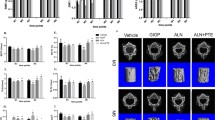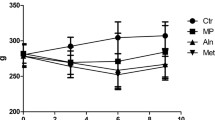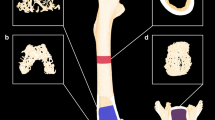Abstract
Objective
This study aimed to investigate the effects of liraglutide on bone metabolism markers in rat models with glucocorticoid-induced osteoporosis (GIOP), including the effects on bone mass, bone tissue microstructure, bone biomechanics, and bone turnover markers.
Method
Thirty male Sprague–Dawley rats aged 8 weeks were randomly divided into three groups: the control group (n = 10) was intramuscularly injected with an equal volume of 0.9% sodium chloride, the dexamethasone group (n = 10) was intramuscularly injected with dexamethasone at 1 mg/kg (twice a week) to induce GIOP, the dexamethasone plus liraglutide group (n = 10) was subcutaneously injected with liraglutide at 200 μg/kg daily, simultaneously. The bilateral femurs and the fifth lumbar vertebrae were collected after 12 weeks to perform micro-computed tomography and bone biomechanical examinations. Also, tartrate-resistant acid phosphatase (TRACP), cross-linked carboxy-terminal telopeptide of type I collagen (CTX-I), alkaline phosphatase (ALP), and osteocalcin (OC) were tested.
Results
The bone mineral density (BMD), bone microstructure, and bone biomechanical markers reduced significantly in the dexamethasone group compared with the control group. The bone resorption indicators (TRACP and CTX-I) increased, while the bone formation indicators (ALP and OC) decreased. After liraglutide treatment, BMD, bone microstructure, and bone biomechanical markers improved significantly. Moreover, TRACP and CTX-I decreased significantly, while ALP and OC increased compared with the dexamethasone group.
Conclusions
Liraglutide improved BMD, bone microstructure, and bone strength and reversed GIOP, primarily through the reduction of bone resorption and promotion of bone formation.


Similar content being viewed by others
References
Drake MT, Clarke BL, Lewiecki EM (2015) The pathophysiology and treatment of osteoporosis. Clin Ther 37:1837–1850
Weinstein RS (2011) Clinical practice. glucocorticoid-induced bone disease. N Engl J Med 365:62–70
Kanazawa I (2017) Interaction between bone and glucose metabolism [Review]. Endocr J 64:1043–1053
DeShields SC, Cunningham TD (2018) Comparison of osteoporosis in US adults with type 1 and type 2 diabetes mellitus. J Endocrinol Invest 41:1051–1060
Hamilton EJ, Rakic V, Davis WA, Paul Chubb SA, Kamber N, Prince RL, Davis TM (2012) A five-year prospective study of bone mineral density in men and women with diabetes: the fremantle diabetes study. Acta Diabetol 49:153–158
Rubin MR (2015) Bone cells and bone turnover in diabetes mellitus. Curr Osteoporos Rep 13:186–191
Pereira M, Jeyabalan J, Jorgensen CS, Hopkinson M, Al-Jazzar A, Roux JP, Chavassieux P, Orriss IR, Cleasby ME, Chenu C (2015) Chronic administration of glucagon-like peptide-1 receptor agonists improves trabecular bone mass and architecture in ovariectomised mice. Bone 81:459–467
Ma CC, Xu SQ, Gong X, Wu Y, Qi S, Liu W, Xu JH (2017) Prevalence and risk factors associated with glucocorticoid-induced osteoporosis in Chinese patients with rheumatoid arthritis. Arch Osteoporos 12:33
De Vries F, Bracke M, Leufkens HG, Lammers JW, Cooper C, Van Staa TP (2007) Fracture risk with intermittent high-dose oral glucocorticoid therapy. Arthritis Rheum 56:208–214
Cairoli E, Palmieri S, Goggi G, Roggero L, Arosio M, Chiodini I, Eller-Vainicher C (2018) Denosumab or oral bisphosphonates in primary osteoporosis: a “real-life” study. J Endocrinol Invest 41:1005–1013
Novelli M, De Tata V, Bombara M, Lorenzini A, Masini M, Pollera M, Bergamini E, Masiello P (1999) Insufficient adaptive capability of pancreatic endocrine function in dexamethasone-treated ageing rats. J Endocrinol 162:425–432
Caperuto LC, Anhe GF, Amanso AM, Ribeiro LM, Medina MC, Souza LC, Carvalho OM, Bordin S, Saad MJ, Carvalho CR (2006) Distinct regulation of IRS proteins in adipose tissue from obese aged and dexamethasone-treated rats. Endocrine 29:391–398
dos Santos C, Ferreira FB, Goncalves-Neto LM, Taboga SR, Boschero AC, Rafacho A (2014) Age- and gender-related changes in glucose homeostasis in glucocorticoid-treated rats. Can J Physiol Pharmacol 92:867–878
Chimin P, Farias Tda S, Torres-Leal FL, Bolsoni-Lopes A, Campana AB, Andreotti S, Lima FB (2014) Chronic glucocorticoid treatment enhances lipogenic activity in visceral adipocytes of male Wistar rats. Acta Physiol (Oxf) 211:409–420
Gallwitz B (2005) Glucagon-like peptide-1-based therapies for the treatment of type 2 diabetes mellitus. Treat Endocrinol 4:361–370
Su B, Sheng H, Zhang M et al (2015) Risk of bone fractures associated with glucagon-like peptide-1 receptor agonists’ treatment: a meta-analysis of randomized controlled trials. Endocrine 48:107–115
Iepsen EW, Lundgren JR, Hartmann B, Pedersen O, Hansen T, Jorgensen NR, Jensen JE, Holst JJ, Madsbad S, Torekov SS (2015) GLP-1 receptor agonist treatment increases bone formation and prevents bone loss in weight-reduced obese women. J Clin Endocrinol Metab 100:2909–2917
Mansur SA, Mieczkowska A, Bouvard B, Flatt PR, Chappard D, Irwin N, Mabilleau G (2015) Stable incretin mimetics counter rapid deterioration of bone quality in type 1 Diabetes Mellitus. J Cell Physiol 230:3009–3018
Ma X, Meng J, Jia M, Bi L, Zhou Y, Wang Y, Hu J, He G, Luo X (2013) Exendin-4, a glucagon-like peptide-1 receptor agonist, prevents osteopenia by promoting bone formation and suppressing bone resorption in aged ovariectomized rats. J Bone Miner Res 28:1641–1652
Yamada C, Yamada Y, Tsukiyama K, Yamada K, Udagawa N, Takahashi N, Tanaka K, Drucker DJ, Seino Y, Inagaki N (2008) The murine glucagon-like peptide-1 receptor is essential for control of bone resorption. Endocrinology 149:574–579
Wen B, Zhao L, Zhao H, Wang X (2018) Liraglutide exerts a bone-protective effect in ovariectomized rats with streptozotocin-induced diabetes by inhibiting osteoclastogenesis. Exp Ther Med 15:5077–5083
Montagnani A, Gonnelli S (2013) Antidiabetic therapy effects on bone metabolism and fracture risk. Diabetes Obes Metab 15:784–791
Sun HX, Lu N, Luo X, Zhao L, Liu JM (2015) Liraglutide, the glucagon-like peptide-1 receptor agonist, has anabolic bone effects in diabetic Goto-Kakizaki rats. J Diabetes 7:584–588
Acknowledgements
This study was supported by the university natural science research fund of Anhui province (KJ2017A174).
Author information
Authors and Affiliations
Corresponding author
Ethics declarations
Conflict of interest
The authors declare that they have no conflict of interest.
Ethical approval
All procedures performed in studies involving animals were in accordance with the ethical standards of the institution or practice at which the studies were conducted.
Informed consent
Not applicable.
Additional information
Publisher's Note
Springer Nature remains neutral with regard to jurisdictional claims in published maps and institutional affiliations.
Rights and permissions
About this article
Cite this article
Yang, L., Yang, J., Pan, T. et al. Liraglutide increases bone formation and inhibits bone resorption in rats with glucocorticoid-induced osteoporosis. J Endocrinol Invest 42, 1125–1131 (2019). https://doi.org/10.1007/s40618-019-01034-5
Received:
Accepted:
Published:
Issue Date:
DOI: https://doi.org/10.1007/s40618-019-01034-5




